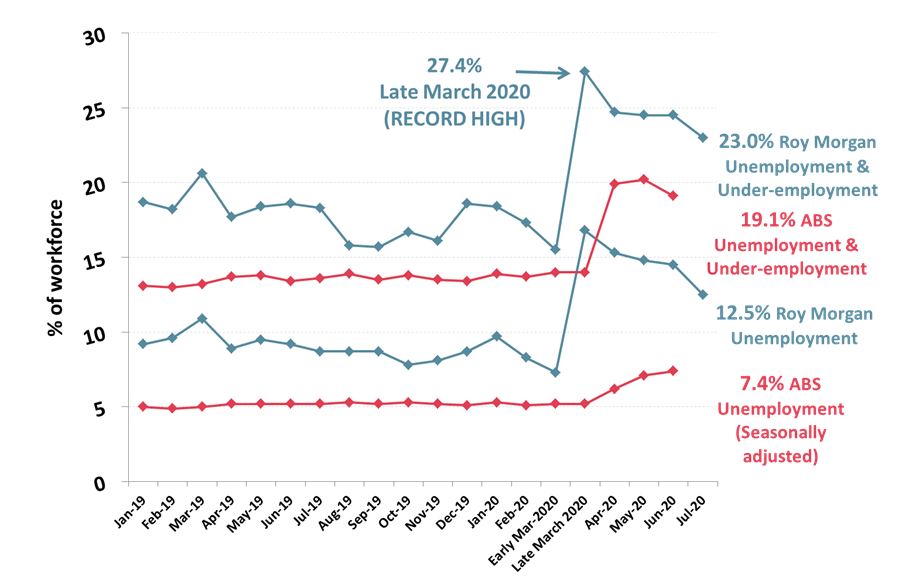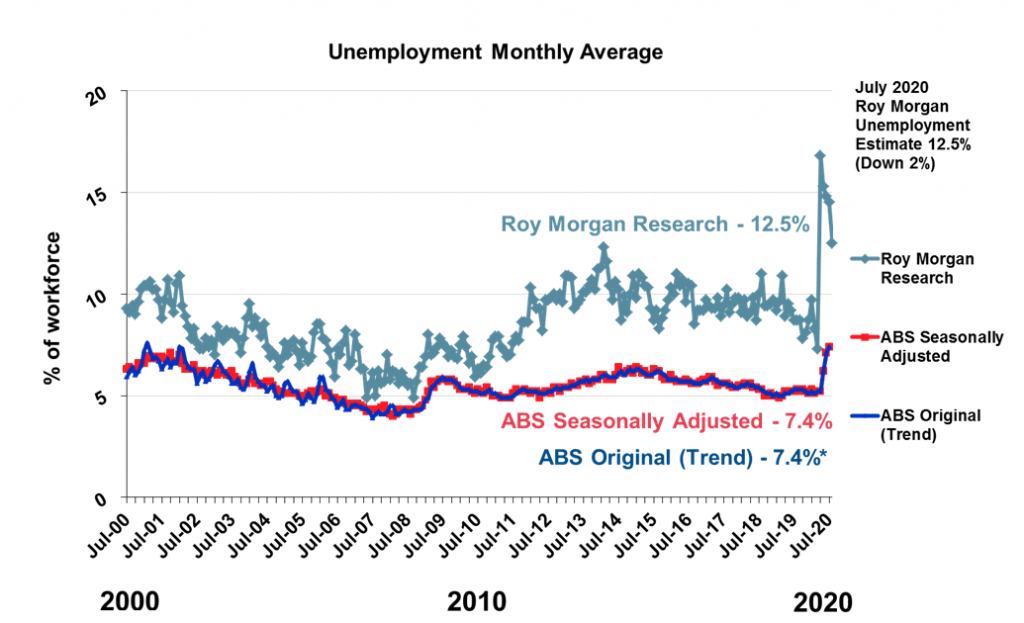Unemployment drops to under 2 million in July as economy re-opens

In July 12.5% of the workforce (1.79 million Australians) were unemployed. This is a significant drop of 262,000 on June as the Australian economy – with the exception of Victoria – continued to re-open.
An additional 1.5 million Australians were under-employed (10.5% of the workforce), up 92,000 on a month ago.
This means a massive 3.28 million Australians (23% of the workforce) were either unemployed or under-employed, an improvement of 171,000 on June according to the latest Roy Morgan employment estimates.
Compared to early March, before the nation-wide lockdown, there are an additional 1.12 million Australians now unemployed or under-employed (+7.4% points).
A look at the trends on a State-based level shows the biggest declines in unemployment in the month of July have been in Queensland, SA and Tasmania with the unemployment rates dropping by over 4% points in each of these States.
Unemployment is down by just over 1% point in both WA and NSW – which now has the lowest unemployment of any State.
Victoria is the outlier with unemployment virtually unchanged on a month ago. The new lockdown in Victoria has seen employment in the State decline around 80,000 on June while the number of Victorians looking for work has also dropped by around 20,000 as the workforce shrinks.
Latest Roy Morgan employment series data for July shows:
- The workforce in July was 14,251,000 – comprised of 12,465,000 employed and 1,786,000 unemployed Australians looking for work. The workforce total is up 145,000 since June driven by a large increase in part-time employment;
- 12,465,000 Australians were employed, up 407,000 from June including 8,013,000 employed full-time, up 79,000, and 4,452,000 employed part-time, up 328,000;
- 1,786,000 Australians were looking for work, down 262,000 from June, driven by a fall in the number looking for part-time work which fell 165,000 to 979,000 while 807,000 were looking for full-time work, down 97,000;
- Roy Morgan’s unemployment figure of 12.5% for July is significantly higher than the current ABS estimate for June 2020 of 7.4%. However, the ABS figure for June estimated a large decline in the size of the workforce since March which they said was down 416,000. The ABS also counted an additional 175,000 Australians who were working zero hours in June as ‘employed’; people who ‘had no work, not enough work available, or were stood down’. If these non-workers are added the ABS unemployment estimate for June increases to 1.58 million (11.9%).
Michele Levine, CEO Roy Morgan, says although most of Australia spent July opening up, the renewed lockdown in Victoria has put the recovery on hold for the State which represents around a quarter of the national economy:
“Roy Morgan’s unemployment measure for July shows 1.79 million Australians were unemployed (12.5% of the workforce) with an additional 1.5 million (10.5%) under-employed. In total a massive 3.28 million Australians (23% of the workforce) were unemployed or under-employed – down 171,000 on a month ago.
“This improvement is not unexpected as most of Australia continued to open up during July and the unemployment rates in Queensland, SA and Tasmania all dropped by 4% points or more on a month ago. All three have seen no community transmission of COVID-19 for at least two months.
“Unemployment also dropped by over 1% point in both WA and NSW – which now has the lowest unemployment of any State at 10.9%. NSW has kept its borders open to the rest of Australia until the recent severe outbreak in Victoria.
“The employment trends in July are positive, but the example of Victoria shows how any gains are put at risk by mistakes made in the containment of the virus. The Victorian laws to contain the virus have been progressively tightened since June but the trend of new cases suggests the current lockdown due to expire in mid-August will be extended into September and cause further economic damage to the State.
“The situation in Victoria is serving as a clear warning to other States, and particularly NSW, to do everything possible to get on top of new outbreaks to prevent COVID-19 re-emerging and forcing another damaging economic lockdown.
“To regain control of the situation in Victoria Premier Daniel Andrews is contemplating a New Zealand style lockdown to get on top of COVID19. If this is to be done it must be implemented immediately rather than waiting until the end of the current lockdown period which would only result in a longer period of lockdown than is necessary causing even more economic damage.”

his Roy Morgan survey on Australia’s unemployment and ‘under-employed’* is based on weekly face-to-face interviews of 695,772 Australians aged 14 and over between January 2007 and July 2020, and includes 5,803 telephone and online interviews in July 2020. *The ‘under-employed’ are those people who are in part-time work or freelancers who are looking for more work.
Roy Morgan Unemployment & Under-employment (2019-2020)



| Contact | Office | Mobile |
| Gary Morgan: | +61 3 9224 5213 | +61 411 129 094 |
| Michele Levine: | +61 3 9224 5215 | +61 411 129 093 |
Margin of Error
The margin of error to be allowed for in any estimate depends mainly on the number of interviews on which it is based. Margin of error gives indications of the likely range within which estimates would be 95% likely to fall, expressed as the number of percentage points above or below the actual estimate. Allowance for design effects (such as stratification and weighting) should be made as appropriate.
| Sample Size | Percentage Estimate |
| 40% – 60% | 25% or 75% | 10% or 90% | 5% or 95% | |
| 1,000 | ±3.0 | ±2.7 | ±1.9 | ±1.3 |
| 5,000 | ±1.4 | ±1.2 | ±0.8 | ±0.6 |
| 7,500 | ±1.1 | ±1.0 | ±0.7 | ±0.5 |
| 10,000 | ±1.0 | ±0.9 | ±0.6 | ±0.4 |
| 20,000 | ±0.7 | ±0.6 | ±0.4 | ±0.3 |
| 50,000 | ±0.4 | ±0.4 | ±0.3 | ±0.2 |
